Cheese Glossary: A Glossary Of The Different Cheese TypesPage 4: Cheese Glossary D To E This is Page 4 of an 12-page article. Click on the red links below to visit other pages. This glossary is protected by copyright and cannot be reproduced in whole or part. You are welcome to link to it.
|
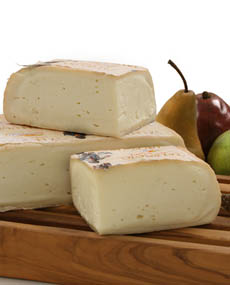 Taleggio, a cousin of Bel Paese, is the softest, creamiest member of the famous Italian Stracchino family of cheeses. It was first made in the Taleggio Valley in the province of Bergamo. It is D.O.P.-protected. Photo courtesy iGourmet. |
|
| D.O. or DENOMINACIÓN DE ORIGEN
In Spain, the Denomination of Origin is a regulated and controlled qualification managed by a council that is responsible for controlling the characteristics and authenticity of food products to protect their agricultural heritage: wines, cheeses, olive oils and other products. It reports to the Ministry of Agriculture. There are analogous bureaus in France (A.O.C.) and Italy (D.O.P.). D.O.P. or DENOMINAZIONE d’ORIGINE PROTETTA Denominazione d’Origine Protetta is the Italian certification of authenticity of origin. Some other countries in the European Union also use D.O.P. now, including Portugal. See also A.O.C. and D.O.
|
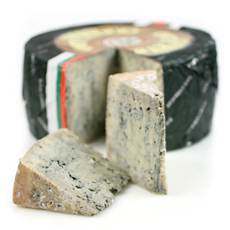 Cabrales, from Asturias, Spain, is an exquisite blue cheese aged in humid caves that enable the development of penicillium molds. Like Gorgonzola and Roquefort, it is often imitated, and requires origin protection. Photo courtesy iGourmet.com. |
|
| DOUBLE GLOUCESTER
First made in the 16th century, this Cheddar-style cheese from Gloucestershire in southwest England has mellow-to-bold orange paste (from annatto) and a sharp flavor. The milk come from the Gloucester cow, a handsome black animal with a broad white stripe running down her back, and the ability to produce the creamy, rich milk from which this cheese is made. “Double” refers to a traditional British recipe that uses cow’s milk from both the morning and evening milkings. Double Gloucester is the cheese used for the annual spring Cooper’s Hill Cheese Rolling and Wake on Gloucestershire’s Cooper’s Hill. Competitors chase a wheel of Double Gloucester down a hillside; the winner is expected to catch the 80-pound wheel. However, as the wheel rolls in excess of 70mph, it might not be possible (or advisable). D.P.O.
|
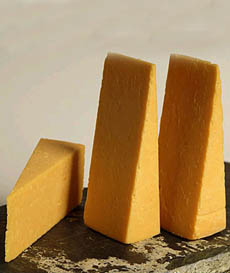 Butler’s Farmhouse Double Gloucester. Photo courtesy iGourmet.com. |
|
| DRAINING The stage of cheesemaking when the whey is drained from the curd. This can take 24 to 48 hours, depending on the size of the cheese. This stage is followed by further drying procedures, such as scalding. These two stages are critical to successful maturation. |
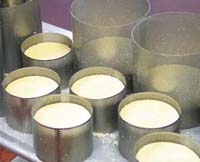 Cheese wheels rest in molds overnight to drain excess whey and become firmer. Photo courtesy of SproutCreekFarm.org. |
|
| DRYING
The stage of cheesemaking when lactic cheeses are left for one to three days in a well-ventilated room, to allow the water to evaporate.
|
||
| DRY MATTER The part of the cheese that remains after all moisture is removed. Soft cheeses, such as Brie and Camembert, will contain on average about 50% dry matter and 50% water. Aged cheeses like Parmigiano-Reggiano are mostly dry matter with very little water.
|
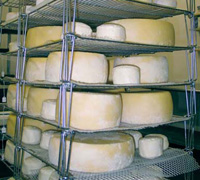 New cheese begins to form a rind within a day of drying. Photo courtesy of SproutCreekFarm.org. |
|
| EARTHY
A descriptive term often used to describe the nature of monastery cheeses.
|
||
| EMMENTHALER or EMMENTALER What most Americans think of as “Swiss cheese,” Emmenthaler is one of the major Swiss cheeses—the one with the large eyes, as they are called in the cheese industry, or “holes” as they are called by American consumers. (There is no cheese named “Swiss cheese in Switzerland, just as there is no cheese named “French cheese” in France, “Italian cheese” in Italy, and so forth. Only Americans thought of cheese so generically as to have a product called “American cheese.”) Emmenthaler is a pressed cheese—the curds are cooked before they are pressed, to provide a more “milky” aroma and flavor than unpressed curds. See photo below and descriptors for pressed curd cheese. Also see Swiss cheese.
|
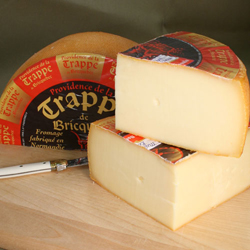 Trappe De Bricquebec, a traditional monastery cheese, is made in the Normandy region of northwest France from pasteurized cow’s milk and aged for a minimum of 6 weeks. Its slightly nutty paste has a spicy finish, which goes well with Belgian-style ales and English cider. Add some bread, fruit and nuts for a light lunch. Photo courtesy iGourmet. |
|
| EYES (HOLES) The openings in the paste of Swiss-type cheeses such as Emmentaler and Gruyère. The holes are spherical and can be small like the head of a pin, or about the size of cherry pits. The eyes are caused by bacterial activity which generates prioponic acid, causing gas to expand within the curd and create the pockets. See Swiss cheese. Continue To Page 5: Terms Beginning With F & G Return To The Article Index Above
|
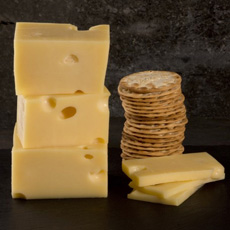 Emmenthaler with the familiar “eyes.” Photo courtesy Murray’s cheese. |
|
Last Updated May 2018
© Copyright 2005-2025 Lifestyle Direct, Inc. All rights reserved. All images are copyrighted to their respective owners.